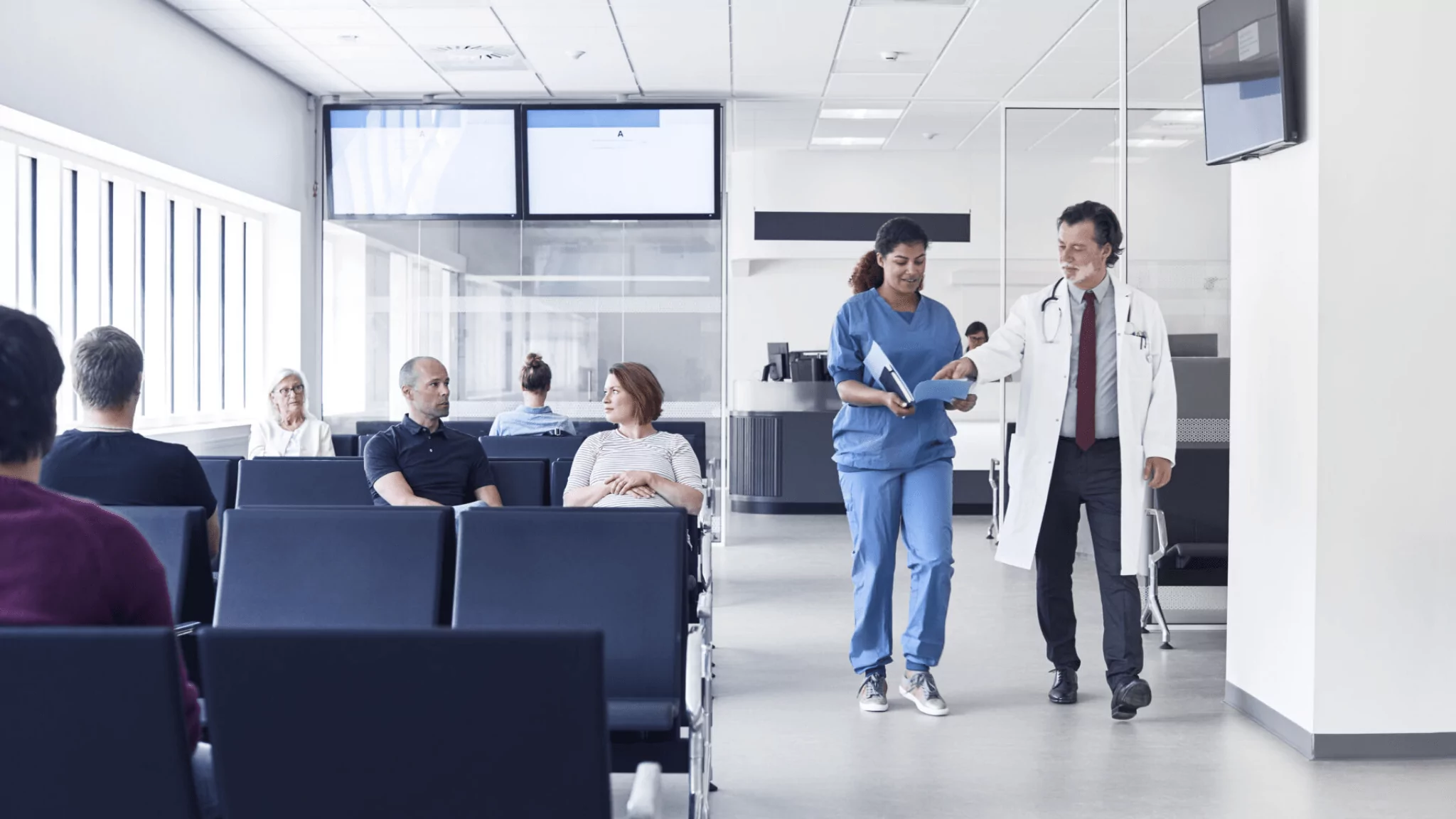“Smart” technologies aren’t just for office spaces and homes. IoT-powered smart solutions are finding any number of useful applications in hospitals and other healthcare facilities. And given the size and complexity of hospitals, it’s easy to see why — going “smart” streamlines processes, creates efficiencies and provides a number of other unexpected benefits. Let’s check out what is a smart hospital nowadays.
Table of contents:
- What is a smart hospital?
- Common challenges in hospitals
- Benefits of a smart transformation in hospitals
- Get “smart” now, enjoy the benefits tomorrow
What is a smart hospital?
Smart hospitals connect physical assets to a network using wireless technologies like Bluetooth Low Energy. This makes it possible to gain insights into the location and status of these assets and manage them remotely.
This is typically done by attaching a tag to a medical device or machine, making it possible to know where it is at times. Small wearable tags can be used by staff or patients, making them visible on the same virtual map of the facility that displays other physical assets.
This ability to gain real-time insights into the location and status of people and assets is the foundation of the many use cases that improve the overall operation of the hospital.
The digitization of physical locations gives stakeholders insights into things like workflows, asset utilization, patient care and overall operational efficiency. Smart hospitals can adapt clinical processes, patient care policies and general facility management based on the data available from tracking the physical location of people and assets.
Just as in their counterparts in office buildings, hospitals get “smart” by leveraging the power of real-time location data.
Common challenges in hospitals?
Before we dive deeper into the solutions provided by smart, IoT-enabled facilities, let’s look at the main problems they address. Due to its unique nature, the healthcare industry faces specific challenges that complicate how it operates. The size and complexity of healthcare facilities often make it easy to lose organizational control over workflows, locate assets and match resources with needs in real time.
Here are some of the most common challenges faced by healthcare today.
1. Inefficient workflows
-
- Recognizing bottlenecks. With so many moving parts, it can be hard to see how just one or two of them cause backups and delays for everyone. Without insights into workflows, identifying the problem is difficult.
-
- Long wait times. When a bottleneck causes a chain reaction, longer wait times at every stage are inevitable. This fundamental metric of the overall experience is foremost in the mind of every patient.
-
- Poor patient satisfaction. Frustration with wait times almost immediately translate into a negative impression of the facility, no matter the reason for the delay or how well the patient issue is resolved.
-
- Reduced HCAHPS scores. A damaged reputation can be very difficult to repair. This is particularly unfortunate when the organizational issue that caused it is so easily solved.
2. Inefficient Patient Room Utilization
-
- Measuring true capacity. With so much in-and-out traffic spread over often massive facilities, the question of how many rooms or beds you have available right now is often a matter of guesswork.
-
- Missed opportunities for patient intake. The sooner patients are processed into a hospital, the better. When it takes longer to verify room or bed availability, that extra time directly counts against the patient experience and possibly patient outcomes.
-
- Optimizing capacity to meet demand. The complexity of hospitals makes it easy to misallocate resources or even to be unaware of how many and what kind of resources are free at a given moment. When you know where everything is, it’s easier to adjust to changing levels of patient traffic while ensuring assets are ready to go when needed.
3. Patient / Provider Time
-
- Long intervals of patient time alone. When staff have to spend time personally locating resources, that necessarily means less face time with patients and yet another negative experience.
-
- Increase in patient and family anxiety. A lack of transparency regarding the real-time location of patients and their current status leads patients and family members to constantly interrupt staff with questions, causing lost staff time and patient frustration.
4. Environmental Conditions
-
- Sub-optimal temperature, air quality, humidity. When not monitored properly, all three of these metrics can impact patient health, comfort and potential for contracting or prolonging infections.
Benefits of a smart transformation in hospitals
Here are some of the main areas of hospital operation that are immediately upgraded by smart solutions.
Medical device management
Searching for certain pieces of equipment or devices is a constant source of wasted time and manpower in healthcare facilities. Having to spend excessive time searching for a device that is clean and ready to use is frequently a complaint of staff and concern for management for obvious reasons — time spent looking for machines or devices is time not spent facilitating the overall workflow and attending to patients.
Real-time location tracking using Bluetooth® LE assets tags reveals the location and identity of assets at room level. That includes areas for laundry and trash, where smaller devices may be lost. It also includes „hoards” of certain kinds of equipment that departments and divisions may maintain to solve their own search problems.
The essence of workflow efficiency is having the right tools at hand when they are needed.
Asset tracking represents a powerful tool for more effective medical device management and dramatically reduces the time spent on searching for the equipment that employees need.
Staff safety & duress
Healthcare workers face unique threats to their safety due to the high-stress atmosphere often caused by aggressive patients, patient family members or others. Nurses are consistently ranked among the most-assaulted professions in any industry.
Security guards have a role to play in these situations, but it is impossible for them to detect and immediately respond to staff duress cases in every room in such a large facility. Often, there is not much time between the start of the problem and a full-scale assault. Healthcare facilities need a real-time location solution that alerts concerned parties the moment a situation gets out of control.
Real-time location tracking solutions enable an immediate response during security emergencies by instantly identifying the exact location of the employee under duress. The technology can be used to activate customizable notifications through visual and audible alarms and alerts, which are pushed to a central command system or wireless mobile device. Nurses can have wearable wireless devices such as smart badge holders that can be activated in different ways in the event of a threatening situation.
Here’s what RTLS does to enhance staff safety:
-
- During threatening emergencies, security staff can locate the precise location of an employee under duress.
-
- Employees have the peace of mind of knowing they are always protected through a simple button-press.
-
- Patients remain unaware of staff duress solutions. When a violent patient attacks a nurse, sending a panic alert can escalate the situation if the patient learns about a security solution.
Indoor Wayfinding
Hospitals and healthcare complexes can be massive, multi-floor and often multi-building facilities, sometimes not unlike a university campus. Even long-time employees may be challenged to quickly locate a particular office or even entire department that is not part of their normal routine.
Visiting or temporary staff, vendors and others in the facility on business frequently have issues when trying to navigate their way around but this is nothing compared to the challenge often posed to the most important group of all — patients.
Traditionally, hospitals and other large healthcare offices have used physical signage, paper maps and even a simple help desk to direct patients and their families to their destinations. Now, with digital solutions based on location data and easy access to Bluetooth-powered applications, connected hospitals can offer real-time maps and even turn-by-turn directions, providing a Google Maps experience but indoors.
Find out more about smart badge technology.
Get “smart” now, enjoy the benefits tomorrow
The technology that powers the solutions that directly address the biggest challenges facing healthcare facilities today is within easy reach. The benefits are many and the results start the moment they go live.
If you’ve not at least started on the road to implementing smart solutions in your healthcare facility, the time is now.
Want to know more about smart hospitals and other solutions? Watch our on-demand webinar on the solutions that address challenges facing every healthcare organization and discover how easy it is to implement them or contact our Sales team to learn how solutions from Kontakt.io can help you.




